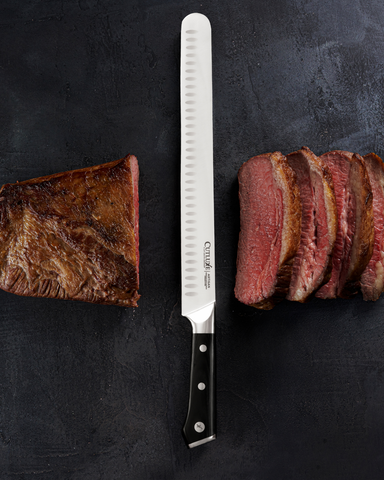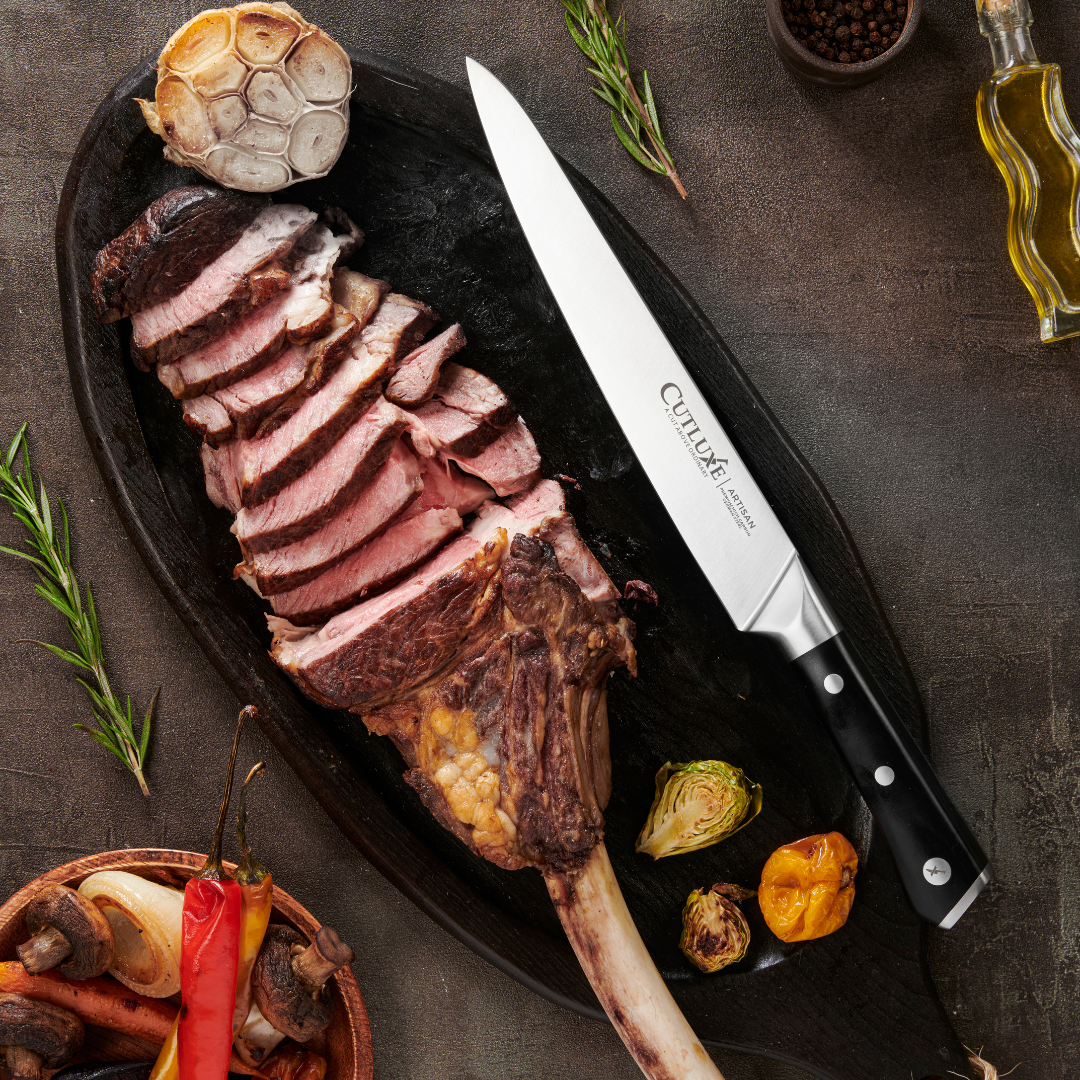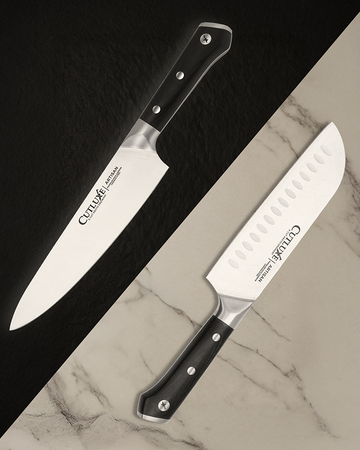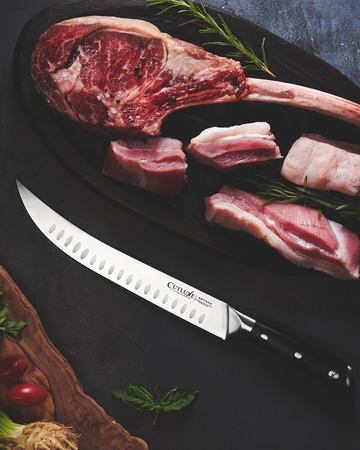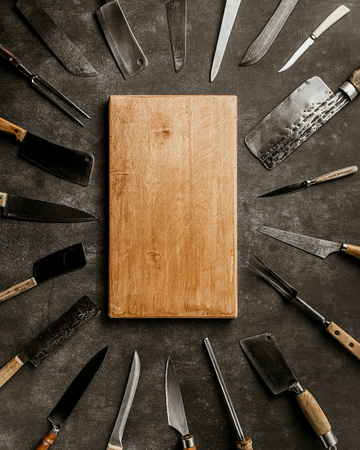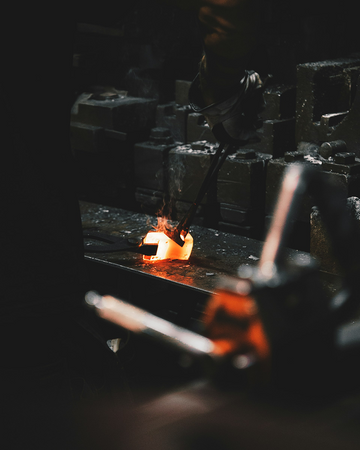Best Slicing Knife for Brisket: Our Top Picks
1. CUTLUXE Artisan Series
12-inch Brisket Knife
Best Overall Knife for Slicing
Pros
• Ergonimic G10 handle
• Carves brisket perfectly
• Durable Japanese Steel
• Comfortable & easy to hold
• High level of craftsmanship
• Durable G10 military-grade handleCons
• A bit expensive

This Cutluxe brisket knife is a work of art made out of German steel. It is forged by professionals and it’s one of the best brisket knives on the market.
It has everything from strength and durability to a perfectly sharpened edge that will carve and slice your meat and veggies with ease. With a full tang blade and an ergonomic design, it offers everything you need for a durable and efficient product.
Blade Length: 4.9/5
The 12-inch high carbon stainless steel blade is the perfect length for cutting even, thin slices without shredding or tearing your meat. The entire length of the knife is super sharp and allows you to cut through your meat without breaking a sweat.
Blade Material: 4.9/5
This Cutluxe carving and slicing knife is a high carbon steel blade that is carefully crafted from premium German stainless steel. The blade is designed flawlessly with a focus on strength and this is shown by a Rockwell hardness that easily lands above 56.
The stainless steel blade has a rounded tip and the qualities of stainless steel make the entire knife corrosion and stain-resistant.
Sharpness: 4.9/5
The blade is sharpened until it’s paper-thin and it features a Granton edge. Each side of the knife-edge is sharpened to an angle of 14-16 degrees for the highest level of sharpness and edge retention.
You can be sure of clean, neat slices each time you slice into your potion. The full tang construction also helps with sharpness and retaining the edge.
Durability and Warranty: 4.9/5
The Cutluxe brisket knife is made out of German steel that is highly durable and resistant to staining and corrosion.
It also comes with a lifetime warranty, which means you can make your purchase without compromising your peace of mind.
2. CUTLUXE Shinobi Series
12-Inch Slicing Knife
Most Durable Slicing Knife
Pros
• Ergonimic G10 handle
• Carves brisket perfectly
• Durable Japanese Steel
• Comfortable & easy to hold
• High level of craftsmanship
• Durable G10 military-grade handleCons
• A bit expensive

This beautiful knife is the key to you making meat cuts that will salivate the tongues of your guests. Imagine combining ancient sharpening techniques and military-grade material. It combines sharpness and durability to give you a product that you can use for years to come.
It allows for a comfortable and secure grip and is designed in a way that prevents wrist fatigue. It gives you value for money.
Blade Length: 4.9/5
The blade length lets you slice through your meat in one fluid motion so that you can evenly cut slices with any thickness of your choosing. It also features a double riveted design that ensures that your grip is sure and firm. Just ensure that you have a carving board that matches the length of the blade and of course let’s not forget a proper knife block.
Blade Material: 4.9/5
This Cutluxe carving knife is the best carving knife on the market and it is carefully and flawlessly carved from the finest Japanese steel. It is made from high carbon stainless steel and boasts of a Rockwell hardness that is above 60. The high carbon Japanese steel is vacuum treated to give the highest level of strength and durability.
Sharpness: 4.9/5
The blade is sharpened to perfection by craftsmen who are highly trained in their area of expertise. The blade is flawlessly sharpened to a mirror finish at 8-12 degrees each side using an ancient method called the Honbazuke method. The blade has a full tang and it is cooled off in Nitrogen to boost durability and sharpness.
Durability and Warranty: 5/5
This carving knife leads the pack when it comes to durability. The G10 military-grade handle was crafted with strength and durability in mind.
It also comes with a lifetime warranty, so you can buy without worry and with no hassle at all.
3. CUTLUXE Olivery Series
12-Inch Slicing Knife
Best for Cutting Meat
Pros
• Extra sharp blade – 14 to 16 degress
• Cuts through meat easily
• Full tang knife
• Olive wood handle
• High-end Sandvik Steel blade
Cons
• Cannot be used in dishwasher
• A bit expensive

The Cutluxe Slicing Knife combines quality, aesthetics, and efficiency to give you one great knife that will always come in handy anytime you decide to start slicing or carving. The quality is exceptional and it makes an excellent overall knife.
This 12-inch CUTLUXE slicing knife cuts through meat like a hot knife cuts through butter. The length and the sharpness of the knife are an added advantage when it comes to slicing through bigger cuts.
Blade Length: 4.9/5
This 12” Slicing Knife is the perfect length for large potions. An extra-long blade when slicing or carving can be one of the things that make or break the finished product, so why not make sure everything is perfect? The length ensures that you can cut through your meat in one fluid motion and this will help you to avoid any bad cuts
Blade Material: 4.9/5
The blade is a full tang, Granton cutting edge, and retains its edge beautifully. The material and quality make it the holy grail of blades. It is a stainless steel blade that is forged from just a single block of high-carbon stainless steel. This means more balance, precision, and durability. Stainless steel is also quite easy to maintain and it is also resistant to corrosion.
Sharpness: 4.9/5
The Cutluxe Slicing Knife has a sharp Granton blade edge that has been meticulously sharpened at 14-16 degrees on each side for the best results. The sharpness ensures that you can cut through your meat with ease and maximum precision.
The Granton blade creates pockets of air that stop your meat from sticking to the blade and it also helps to keep your food intact by preventing shredding. You can even use this high-quality slicing knife for your thanksgiving turkey and your roast beef.
Durability and Warranty: 5/5
The Cutluxe Slicing Knife is highly durable and comes with a lifetime warranty, so you can get this beauty with your heart at ease.
But even with these perks, it is still advisable to practice basic knife care and maintenance to make your blade retain its sharpness for longer and generally last longer.
4. SpitJack BBQ
Slicing & Carving Knife
Most Affordable Carving Knife
Pros
• Affordable option
• Lots of bang for your buck
• Versatile
Cons
• Not that durable
• Plastic handle
• Short blade

This blade from Spitjack is a slightly shorter blade than the other blades we have talked about so far but it still gets the job done neatly and efficiently and gives you smooth slices.
This SpitJack BBQ knife has a stainless steel blade with a sharp edge and it is ergonomically designed with a plastic handle that is designed to fit your palm perfectly. It gives you an efficient yet affordable way to slice meat and will fit in perfectly with your other bbq knives and kitchen tools. However, this knife is a little cheap and is prone to becoming dull.
Blade Length: 4.9/5
This slicing knife has an 11-inch Granton edge alloy steel blade that is sharpened to perfection in the factory. The length makes it the perfect carving knife and you can slice through your brisket in one go. You can also store it safely with your other kitchen knives to avoid accidents.
Blade Material: 4.9/5
This slicing carving knife is made of alloy steel and features a plastic ergonomic handle. The high-quality steel translates to higher edge retention and high durability.
Overall, this is a good carving knife. Like many high-quality meat carving knives, the Granton edge or scalloped edge stops the meat from sticking to the knife by creating little pockets of air between the meat and the blade as you carve.
Sharpness: 4.9/5
This knife is butcher sharp and the straight edge is meticulously and efficiently honed in the factory for your convenience. The high-quality alloy steel means that it will retain its edge for longer and you also have the option to sharpen the knife and restore the edge in the event that the blade edge begins to dull.
Durability and Warranty: 5/5
As we have mentioned, there are some durability concerns with this blade. For starters, the handle is made with plastic and is prone to breaking. The blade itself can dull easily.
This smoked brisket knife does not have a lifetime warranty but you can return it, get a refund, or get a replacement if you need to within 30 days of receipt.
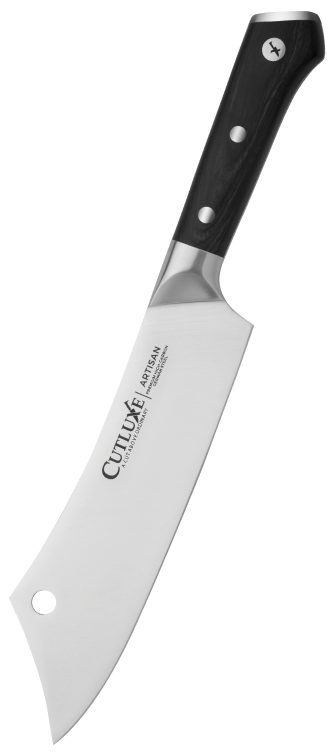
- Razor-sharp hybrid cleaver blade
- Ideal for meat and veggies
- Hand-sharpened German steel edg
- Full-tang for added strength
- Ergonomic pakkawood handle grip
- Heavy-duty yet precise control
- Designed for all daily prep
- Rust-resistant, easy to clean
- Superior balance and durability
- Backed by lifetime warranty
5. CUTLUXE Artisan Series
9-inch Slicing Knife
Best for Diverse Cutting Needs
Pros
• Razor-sharp
• Ergonomic handle design
• Durable German steel
• Versatile knife – great for many needs
Cons
• Might not cut through big meat slices
• Blade is only 9 inches

This 9-inch carving knife from Cutluxe has everything from a pointed blade made from German steel to a Pakkawood ergonomically designed handle. It is a multi-purpose knife that works with different types of meats and even fruits and vegetables. Let’s talk about some of the qualities in further detail.
Blade Length: 4.9/5
This is one of the best carving knives in the market if you need something a little smaller than what we have discussed so far. The blade is 9-inches long and has a razor-sharp pointed end. The blade is thin and you can easily cut even thin slices. This also makes a perfect chef’s knife.
Blade Material: 4.9/5
The blade material is durable German Thyssenkrupp steel. This is full tang high carbon steel that has a Rockwell hardness that is very strong. It is durable and naturally resistant to corrosion and staining. The handle has an ergonomic design with a Pakkawood handle that is triple riveted for the most comfortable fit.
Sharpness: 4.9/5
The sharp blade has a Granton edge and tapers to a pointed tip. It is sharpened by hand to a precise 14-16 degrees on each side which is ideal for cutting through meat.In addition to the sharpness, the blade perfectly retains its edge over time, so you can slice away to your heart’s content and achieve paper-thin slices.
Durability and Warranty: 5/5
The German steel and the Pakkawood handle are highly durable and maintain their look even with time. Just be sure to take good care of the knife, clean it regularly, and perform normal maintenance.
This Cutluxe carving knife comes with a lifetime warranty, so you can buy it without worrying about defects or problems down the line.

